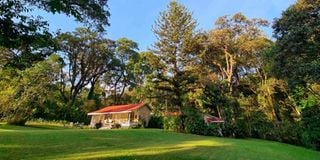A spontaneous trip to Kakamega Forest

Rondo retreat.
For some reason, western Kenya has eluded me. I am fortunate to travel across the country extensively, but I had not ventured along the A104 beyond the Mau since I was a youngster on a family trip to Lake Victoria and Uganda. Yet, as a keen naturalist, there are attractions there that I simply must visit.
For ages, I had talked about taking a circular trip to find roan antelope in Ruma National Park, spot-necked otters off Rusinga Island, cave-mining elephants on Mt. Elgon, sitatunga antelope in Saiwa Swamp, and then all the weird and wonderful creatures found only in Kakamega Forest.
Then, the other day, a friend who works in Amboseli called wanting to celebrate her birthday on safari somewhere altogether contrasting. We were curious about Kakamega and it seemed the perfect solution.
Kakamega is truly unique. It is a tiny remnant of what was once the huge Guineo-Congolian rainforest that straddled the continent from the Atlantic across to the Gregory Rift. It’s now an island in a sea of agriculture, hundreds of kilometres east of the forest it was once connected to.
Decent protection
It means there are unusual animals there, found nowhere else in Kenya – some even nowhere else on the planet. It is Kenya’s only true rainforest, and it is thankfully now getting some decent protection after years of exploitation.
As far as we could tell, the best accommodation there is Rondo Retreat, a former forestry station now run by the Trinity Fellowship. We drove up from Nairobi through Nakuru, before turning off before Eldoret and then onto the forest via Kapsabet. It took us just under eight hours along smooth roads. The last few kilometres are murram, with directions well signposted.
Rondo’s entrance looks nondescript, as if we were turning into a suburban home in Karen. We entered to find ourselves in a clearing with immaculate lawns and flowerbeds, surrounded by tall primary forest, punctuated with white-painted wooden cabins with huge verandahs and vivid red roofs. The rooms are quaint and all en-suite, some more recently renovated than others.
We didn’t need to venture far to sample the famous birdlife. High above the main building is a crowned eagle’s nest, with last year’s fledgling still hanging around. We watched him terrorise the resident baboons, emphasising his status as apex predator in these parts.
A colony of Vieillot’s black weavers shared his tree. Black-and-white casqued hornbills and yellow-billed barbets were nesting in holes only a few trees further down.
Longer walks
There are a few beautiful self-guided walks around Rondo, along well-maintained paths. Strategically placed benches invite you to sit down and soak up the forest.
Rondo helped us organise guides for longer walks. They have a pool of local experts, and over the next two days Abraham and Winston took us to the spectacular Yalla River, up Lirhanda Hill for sunrise, and into the forest in search of blue-headed bee-eaters and other ‘specials’. I will go for a night-walk when I return, to search for elusive forest mammals such as potto, white-bellied pangolin, and flying squirrels.
While I might be a bit of a nerd and keen to explore the forest for all its oddities, this place is for anyone enticed by a dose of natural beauty and relaxation.
Important to know is that Rondo is remote and at least an hour from shops. It does not have a liquor licence, but it allows you to bring your own.
Their menu is tasty but simple, so bring your favourite condiments and snacks should you crave them. Pre-arrange your guides and pricing for each activity, and be prepared for rain in most months.
For those not wanting to drive, Kisumu’s airport is 90 minutes away, and taxis can be arranged for Sh5,000 each way. I intend to return, hopefully as part of that epic western road trip.
More information can be found at www.rondoretreat.com





